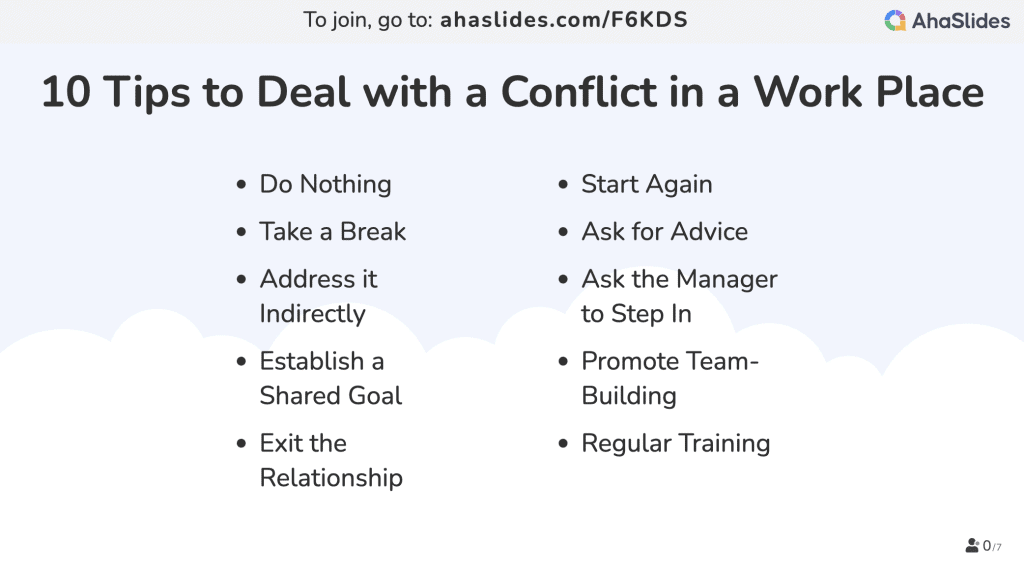Why is conflict common in the workplace? Conflict is what no company expects but it just happens regardless of huge efforts to anticipate. Like the complexity of organizational structure, conflict in a work place occurs for many reasons and in different contexts that are hard to forecast.
This article tries to solve the myth of conflict in a work place from multiple perspectives and looks at different types of conflicts and their causes to help companies, employers, and employees deal with them effectively.
Table of Contents:
- What is Conflict in a Work Place?
- Types of Conflict in a Work Place, Causes, and Examples
- 10 Tips to Deal with a Conflict in a Workplace
- Bottom Lines
- Frequently Asked Questions

Get your Employees Engaged
Start meaningful discussion, get useful feedback and educate your employees. Sign up to take free AhaSlides template
🚀 Grab Free Quiz☁️
What is Conflict in a Work Place?
Conflict in a workplace is simply the condition in which two or more individuals’ concerns appear to be incompatible, which might affect their work and position. This misalignment takes place due to opposing goals, interests, values, or opinions. They can result in tension, disagreement, and a struggle for resources or recognition. Several experts have contributed insights to our understanding of workplace conflict:

Types of Conflict in a Work Place, Causes, and Examples
Learning different types of conflict in a work place is the first step to deal with them effectively. It is a reason why Amy Gallo wrote the Harvard Business Review Guide to Managing Conflict at Work. She mentioned the four main types of work conflict which include status conflict, task conflict, process conflict, and relationship conflict. Here is a comprehensive description of each type, causes, and examples.

Status Conflict
Description: Status conflict involves disagreements arising from differences in perceived status, power, or authority within the workplace, are popular in flat organizational structure. It revolves around issues related to hierarchy, recognition, and influence.
Causes:
- Unequal distribution of power.
- Lack of clarity in roles and responsibilities.
- Differences in expertise and experience.
- Differing opinions on leadership styles.
Examples:
- The millennial generation has been promoted to a management position. But maybe other older peers don’t think that he should have been promoted.
- Disputes over decision-making authority within a team or project. Conflicts arise when team members or leaders disagree on who should have the final say in making decisions within a particular project or team.
Task Conflict
Description: Task conflict emerges from differences in opinions and approaches to the actual work being done. It often involves varying perspectives on executing tasks or achieving goals.
Causes:
- Divergent viewpoints on work methodologies.
- Varied interpretations of project objectives.
- Disagreements on the allocation of resources for a project.
Examples:
- Team members debate the best strategy for launching a new product campaign. Some team members advocated for a heavy focus on digital marketing, while another faction within the team preferred print media, direct mail, and event sponsorships.
- Disagreements on a legal team and sales are dealing with a contract. While sales see the goal as to close the contract as quickly, a legal team sees it as a way to protect the company.
Process Conflict
Description: Process conflict revolves around disagreements in the methods, procedures, or systems used to accomplish tasks. The process conflict is disagreement over how, such as how work is organized, coordinated, and executed.
Causes:
- Differences in preferred work processes.
- Misalignment in communication methods.
- Disagreements on the delegation of responsibilities.
Examples:
- Team members argue over the most effective project management tools. Team members became frustrated with the constant changes and the challenges of adapting to different tools.
- Disputes over the workflow and coordination processes within a department. One group favored a more centralized approach, with a single project manager overseeing all aspects. The other group preferred a decentralized structure, giving individual team members more autonomy in their project management.
Relationship Conflict
Description: Relationship conflict is related to personal feelings. It involves interpersonal disputes and tensions among individuals in the workplace. It is a mistake to think it is personal. It goes beyond personal disagreements, delving into the complex dynamics of interpersonal interactions within the workplace.
Causes:
- Personality clashes.
- Lack of effective communication.
- Past unresolved issues or conflicts.
Examples:
- Colleagues have personal disagreements that spill into professional interactions. He or she snaps at their colleague or raises their voice, and the person feels like they are being disrespected.
- Team members were harboring resentment due to previous unresolved conflicts. These conflicts had festered over time, negatively impacting both individual well-being and team dynamics.
10 Tips to Deal with a Conflict in a Workplace
How did you handle a conflict at work? Here are some tips for dealing with conflict in the workplace, especially for individuals.

Do Nothing
Jeanne Brett at Northwestern calls this the lump option, where you choose not to react immediately For example, if someone says something snarky to you, just don’t do anything about it. Because the chance to be unreasonable like them high, and it cannot solve the conflict at any point.
Take a Break
Sometimes, the best thing you can do is leave the conflict behind and have time to think about it after calming down. Especially after you have a good night's sleep, it often leads to more constructive conversations. It is not about avoidance, your brain just needs time to gain perspective. You can say: "I really want to solve this. But now, I’m not ready to do that right now. Could we talk about it tomorrow?"
Address it Indirectly
In many cultures, like the US and certain office cultures, addressing conflict indirectly may be a viable option. For example, passive aggression can be displayed by indirectly expressing negative feelings or resistance. Instead of openly addressing a conflict, individuals may convey their dissatisfaction through subtle actions, sarcasm, or other covert means. Where a direct conflict is not going to get you what you need, this unconventional approach can be effective.
Establish a Shared Goal
To address a conflict directly, it's important to find a common goal. Establishing clear communication channels can be crucial in resolving conflicts effectively. Consider using good opening lines to start the conversation and keep it going. When you can establish common ground, you'll be in a better position to work together and solve the problem.
Exit the Relationship
This isn't always possible, but you can try if the conflict is really intense. Think of leaving the job, and exploring alternative job opportunities. The chance to get a new boss, or get reassigned to a different task that fits you is likely high.
Start Again
Rebuilding respect for the person involved can be a proactive step. You might also reestablish your respect for that person whatever the past is the past, it is time to move forward with a fresh perspective. You can say something like: " Can we talk about how to get over these disagreements so that we can both do that?"
Ask for Advice
If you are dealing with someone who is being unreasonable, one way to approach the situation is to express that you have been trying to solve the issue together for a while, but it seems like no progress is being made. You can then ask for their advice on what you should do: "Do you have any advice about what I should do?" This approach forces the person to think about it from your perspective. It helps to turn the tables a little bit and enlist the person in addressing the issues.
Ask the Manager to Step In
If the situation is preventing either of you from doing your job, you may need to seek assistance from your managers to find a solution. Requesting their intervention can bring a neutral perspective and facilitate a solution.
Promote Team-Building
This tip is for leaders. Strengthening interpersonal connections can contribute to a healthier work atmosphere and anticipate conflict to arise. Indeed, engaging in team-building activities helps build camaraderie and trust among team members.
Regular Training
Host some training about conflict resolution. A well-trained team is better equipped to recognize and address potential conflicts before they become major disruptions. It helps promote a team culture and growth mindset. Team members with a growth mindset are more likely to approach conflicts with a constructive attitude, seeking solutions rather than placing blame.
Bottom Lines
"Your closest friends are probably all the ones you’ve occasionally had a fight with us". If we can't eliminate it entirely, we can certainly take proactive steps to manage and mitigate it effectively.
Frequently Asked Questions
What is an example of a conflict situation at work?
Some common examples of work conflict are bullying, discrimination, and harassment, which are serious to the well-being of individuals and the overall workplace environment, and they demand immediate attention and intervention.
How do you talk about conflict at work?
When disagreement happens in the workplace, rather than avoiding it, it's essential to address the conflict openly and constructively. Effective communication about workplace conflict involves encouraging colleagues to acknowledge each other's views & concerns and promotes effective communication in workplace conflicts.
What are the 5 common ways to handle conflict?
Kenneth W. Thomas, a psychologist known for his work on conflict resolution, developed the Thomas-Kilmann Conflict Mode Instrument (TKI), which identifies five conflict resolution styles: competing, collaborating, compromising, avoiding, and accommodating. According to Thomas, understanding and using these styles can help individuals navigate and resolve conflicts effectively.








